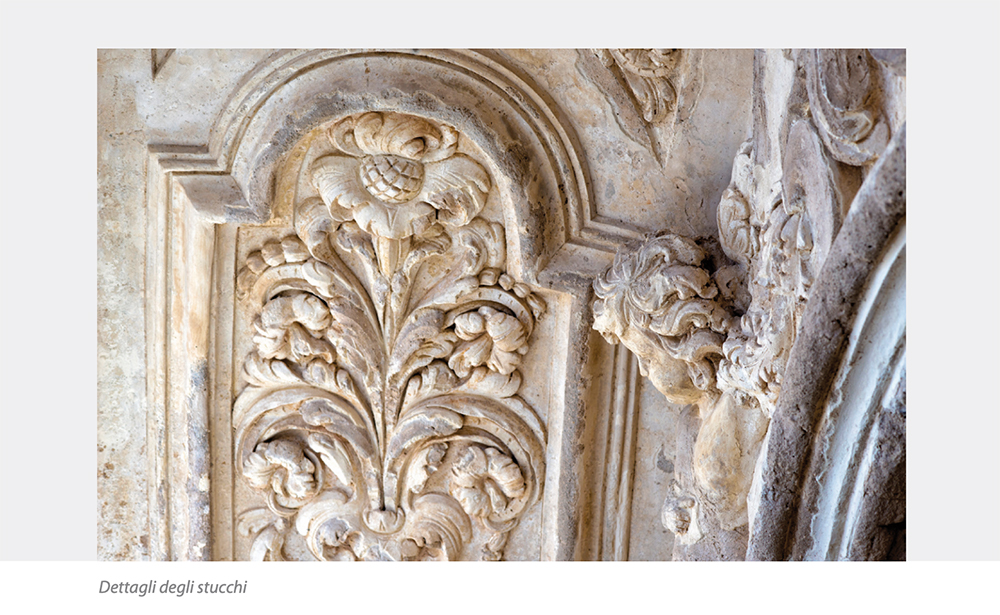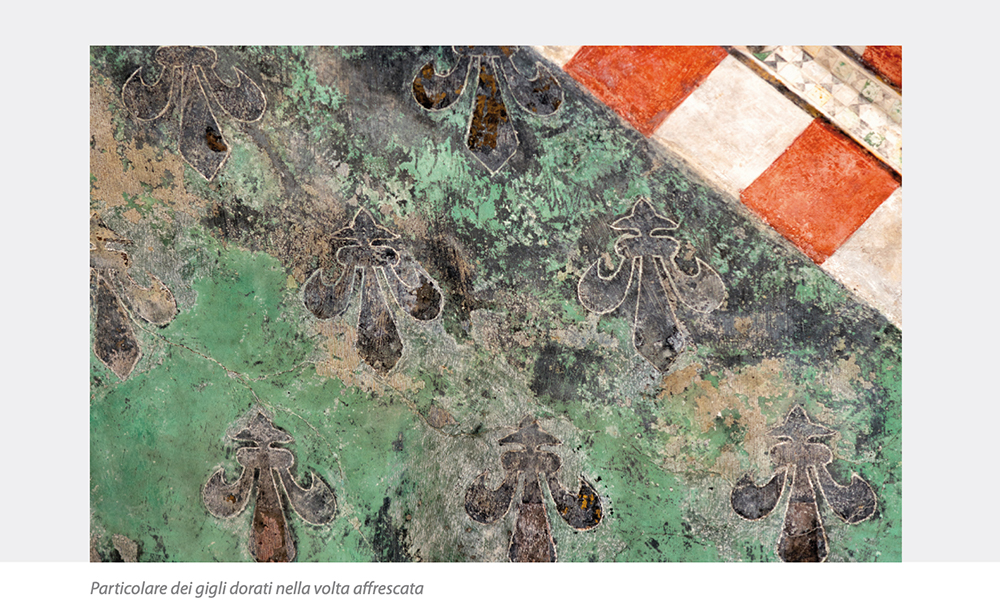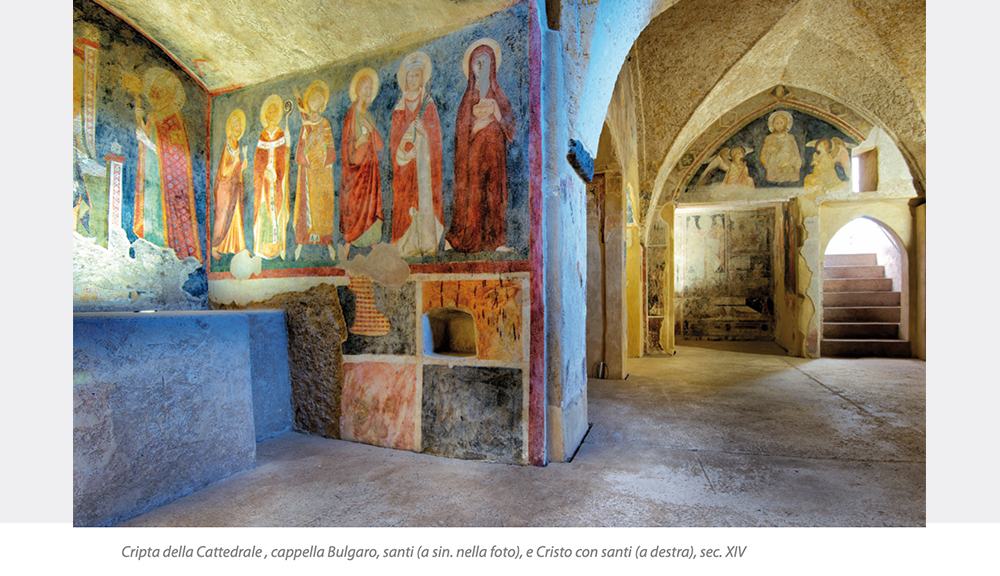They are the survivors of a large group of silent witnesses.
For over a century, they observed from above the sumptuous celebrations in the great cathedral dedicated to the Assumption, the religious heart of the Aragonese Castle, which had already ceded almost all its functions and population to the large island. Scattered in every corner, the chubby putti had represented, in those first decades of the 18th century, the new prevailing taste to which all the sacred buildings of Ischia were gradually adapted.

And the mother church still on the Insula Minor was not an exception. By the will of Bishop Capecelatro, almost nothing of the ancient style had been saved to leave the space for the Rococo styles that were then in vogue. Including the stuccoes introduced to embellish walls, arches and columns, entrusted to the Starace brothers, Francesco and Cesare, for thirty years they were assiduous on the island for works in the churches of Ischia Ponte and in Forio, Panza and Barano, the best of of the capital's architects.
Time was needed to find the «signature » of the Starace in the cherubs of the ancient cathedral spared from English bombings, which in summer 1809 destroyed a considerable part of the temple. And many other edificies of the castle, won and wounded for the first time in its history by so many sieges and as many victorious resistances. . Until last autumn, when the restoration began to save them from a fate that seemed already sealed.
The expert hands of the restorer proceed delicately in order to consolidate the plasters that were pulverising. The study of the surfaces has revealed an extremely high quality manufacturing technique in the cherbus. The angels were modeled in the masonry giving each face, under the rebellious curls, the look and expression that make it unique: sulking, surprised, smiling, curious, dreaming ... This is how Starace worked, that is their "signature". Also evident in the flowering branches, returned to their original splendor. Therefore there was no need to rebuild or remodel with marble dust, which will only serve to preserve them in the future from atmospheric agents.
The work in what remains of the apse is only the most recent of the many interventions made in recent years on the Castle, between the ancient cathedral covered only by the sky and the crypt below. Now a continuous restoration, the result of the partnership
with the European Institute of Restoration, which is based on the fortress, with the supervision of the Superintendency and the scientific collaboration of the Opificio delle Pietre Dure in Florence (workshop of semi-precious stones). Thanks to these synergies, the ancient sacred complex has begun to tell a complex and exciting story, which for centuries has fallen into oblivion.
The restoration of the chapel to the left of the apse had already brought to light stuccoes of a heavy Baroque, of Spanish taste. The beginning of the cathedral's Baroque revolution is indicated in the last years of the 1600s. But the recovery of what remained of the left aisle had also highlighted one of the arches of piperno characteristic of the sixteenth-century church and still angels, in the traces of a fresco of clear Renaissance origin. Few elements, however sufficient to throw a beam of light on the artistic-architectural value that the Cathedral of the Assumption must have had in the moment of maximum splendor of the City of Ischia, a faithful lookout and guardian of the gulf and, therefore, of the fate of Naples and of the Aragonese kingdom.

The impregnable fortress, where the governor Costanza D'Avalos and the young poet Vittoria Colonna (Marino 1490-Rome 1547) spent over thirty years of her life on the Castle, the "rock" mentioned in her "Rhymes" animated one of the most important cultural cenacles of Italian Humanism. And under the frescoed vaults of the cathedral, on December 27, 1509, the wedding between Vittoria and Ferrante D’Avalos, Constance's nephew, was celebrated, handed down in the chronicles for their pomp and illustrious presence.
Behind the piperno arch another unknown piece of the cathedral's history emerged a few years ago. Thanks to the lack of ancient plants and drawings. In carrying out the preliminary tests to consolidate the vault of a chapel that had always been closed, colored reflections were noted. Therefore, this is how it was discovered, by chance, once the vault below was completely frescoed. Once the gray eighteenth-century layer was removed, part of the 14th century church came to light, with the golden lilies of the house of Anjou on a green-turquoise background, surrounded by white and red geometric decorations.
And below some gutters with frescoes of sacred figures emerged, which must have been present throughout the rest of the church in its original version from the Angevin era.
The cathedral of the Castle, in Gothic style, already open for worship in 1306, had only been built a few years ago when King Robert of Anjou visited it with Queen Sancha and a large group, in the spring of 1309. The first sacred building built after the volcanic eruption of 1301, which had depopulated the large island, in front of the fortified islet. Where the islanders, returning after the natural event, had settled in large numbers, moving all the functions of the city of Ischia. And also the cathedral, where the noble families residing on the fortress later called the best artists active in Naples, at the time of Giotto's presence. (Giotto, called to Naples by Robert of Anjou in 1328, was the first court painter and remained there until 1333. He worked in Santa Chiara and Castel Nuovo and trained numerous local artists).

The Giotto school is the connexion between the upper church and the below edifice, identified as the crypt of the cathedral, but actually a pre-existing autonomous church. And the fourteenth century frescoes of the Bulgaro chapel, now fully restored, have been connected to Giotto’s style atists of the Angevin court. Like the paintings in the cathedral.
Another of the secrets of the crypt has already been revealed. Years ago, during the inspection of a battered wall, an underlying deposit of earth and bones was found. In removing the contents, then, surprisingly painted walls appeared: it was a hidden chapel. The restoration has recovered works painted by different hands in different periods: the oldest paintings, of Byzantine influence, of the
end of the Thirteenth century, show a pre-existence of that place of worship to the crypt itself. While a "Christ between the Madonna and St. John", from the 1440s, for the historical-artistic person in charge of the Serena Pilato Castle, could be the Maestro di Giovanni Barrile’s work.
A Neapolitan artist among the most active Giotto’s pupils with whom he collaborated to the construction of the Castel Nuovo and of Santa Chiara, the Maestro is identified by the name of the Barrile chapel which he painted in San Lorenzo Maggiore.
A thirteenth-century coat of arms made it possible to attribute the ownership of the ancient chapel to the Calosirto family, who in 1654 gave birth to the Saint from Ischia, Giovan Giuseppe della Croce.
Behind the stone wall of the Baroque apse there is a cavity. Essays are being planned to verify what is behind it. The surprises in the ruins of the cathedral may not be over...
Information
Open 7 days a week, all year, from 9am until sunset
full ticket: 12€
reduced ticket: 10€
© ALL RIGHTS RESERVED



Comments powered by CComment